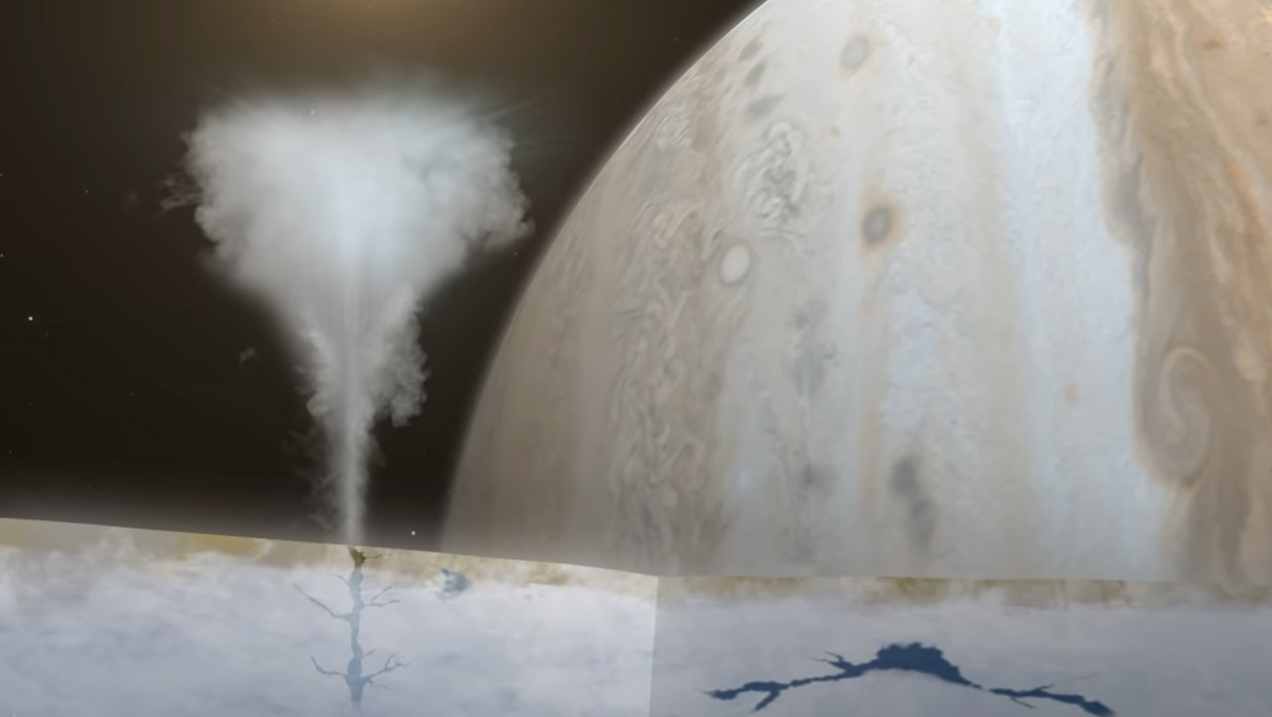Scientists peer back in time to find new evidence for watery plumes on Europa
A new study uses observations from 2000 to find new evidence for Europa's plumes.

Scientists looked back in time to offer new evidence suggesting that plumes of water vapor shoot out into space from Jupiter's moon Europa.
In 2016, using observations from the Hubble Space Telescope, scientists found evidence for what they'd long suspected, water vapor plumes shoot out from Europa, stemming from the moon's hypothesized subsurface ocean. Now, in a new study, scientists led by European Space Agency research fellow Hans Huybrighs used 20-year-old data from NASA's Galileo mission to provide even more evidence for these plumes.
Europa, one of Jupiter's 79 known moons, was discovered in 1610 by astronomers Galileo Galilei and Simon Marius along with the rest of the planet's four relatively large "Galilean moons." More recently, NASA's two Voyager spacecraft, the Hubble Space Telescope and the Galileo spacecraft have all observed the moon up close, providing scientists with essential data about the far-off world. These observations have helped scientists to explore and find evidence for the moon's plumes and ocean, which are said to be covered by a thick layer of water ice.
Related: Possible water plumes on Europa: The discovery in images
In this new study, researchers used observations made by the Galileo spacecraft to simulate the movement of positively charged subatomic particles called protons near the moon. While flying by the icy world in 2000, Galileo found fewer protons around Europa than researchers expected. They chalked this up to issues with the probe's instrument.
But in the new research, Huybrighs' team found that some of these "missing protons" weren't registered because a water plume shooting out from the moon blocked them from the instrument. A different instrument on Galileo conducted magnetic field studies of the moon, and the researchers were able to show a disruption in nearby magnetic fields when the plume shot out to support their theory.
ESA aims to probe this world closer with its highly-anticipated mission JUICE (Jupiter Icy Moons Explorer). This mission, should launch in 2022, will explore Jupiter and its many moons and will have instruments on board capable of taking and studying samples from the plumes shooting out from Europa.
Get the Space.com Newsletter
Breaking space news, the latest updates on rocket launches, skywatching events and more!
NASA will also be sending a probe to the moon. The agency's Europa Clipper spacecraft is set to launch in 2024 to Europa where it will study the moon through a series of flybys and up-close observations.
This work was detailed in a new study, published April 29 in the journal Geophysical Research Letters.
- NASA Europa Mission Could Potentially Spot Signs of Alien Life
- Photos: Europa, Mysterious Icy Moon of Jupiter
- Keck Observatory: Twin Telescopes on Mauna Kea
Follow Chelsea Gohd on Twitter @chelsea_gohd. Follow us on Twitter @Spacedotcom and on Facebook.
OFFER: Save 45% on 'All About Space' 'How it Works' and 'All About History'!
For a limited time, you can take out a digital subscription to any of our best-selling science magazines for just $2.38 per month, or 45% off the standard price for the first three months.
Join our Space Forums to keep talking space on the latest missions, night sky and more! And if you have a news tip, correction or comment, let us know at: community@space.com.

Chelsea “Foxanne” Gohd joined Space.com in 2018 and is now a Senior Writer, writing about everything from climate change to planetary science and human spaceflight in both articles and on-camera in videos. With a degree in Public Health and biological sciences, Chelsea has written and worked for institutions including the American Museum of Natural History, Scientific American, Discover Magazine Blog, Astronomy Magazine and Live Science. When not writing, editing or filming something space-y, Chelsea "Foxanne" Gohd is writing music and performing as Foxanne, even launching a song to space in 2021 with Inspiration4. You can follow her on Twitter @chelsea_gohd and @foxannemusic.










